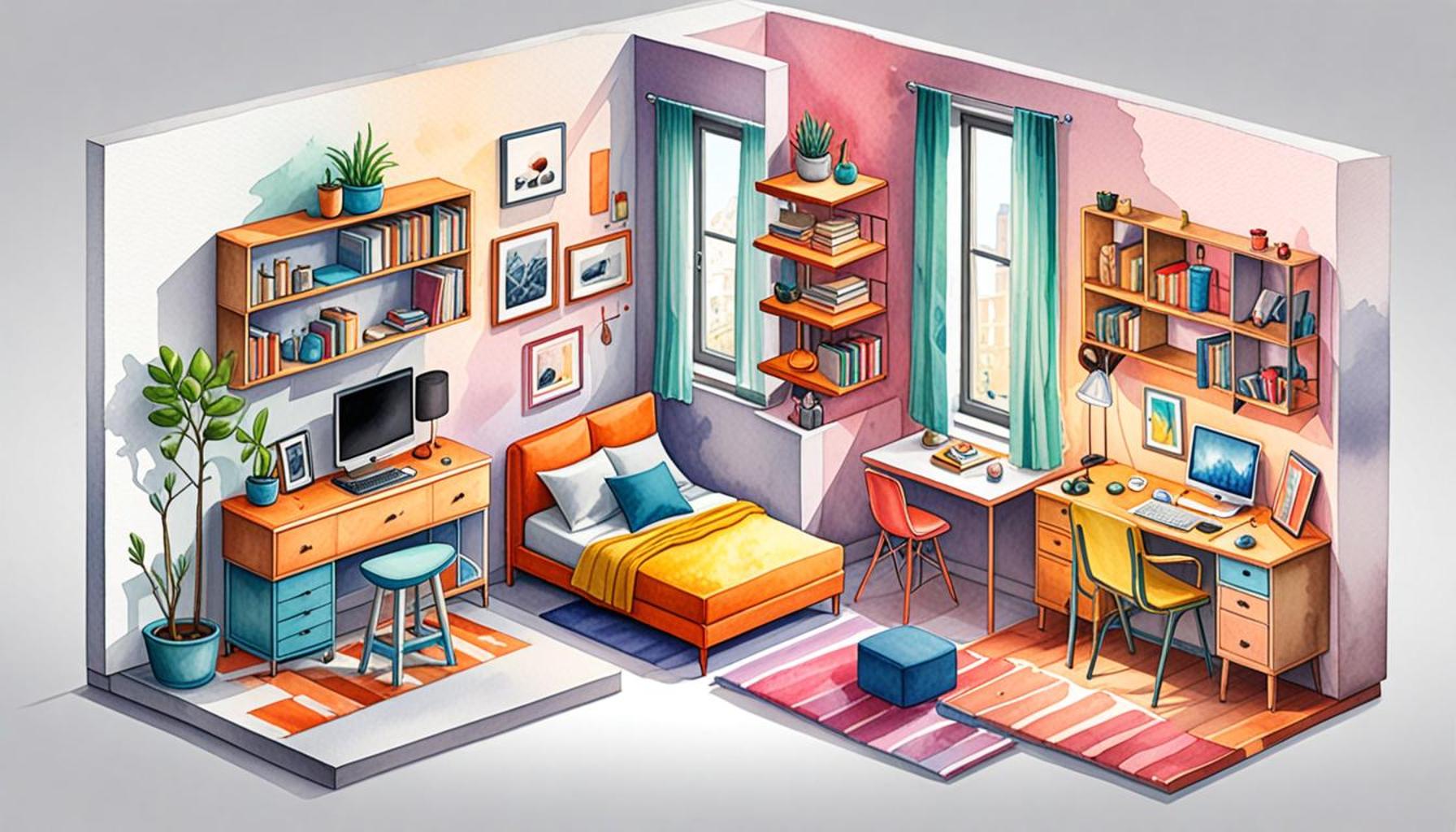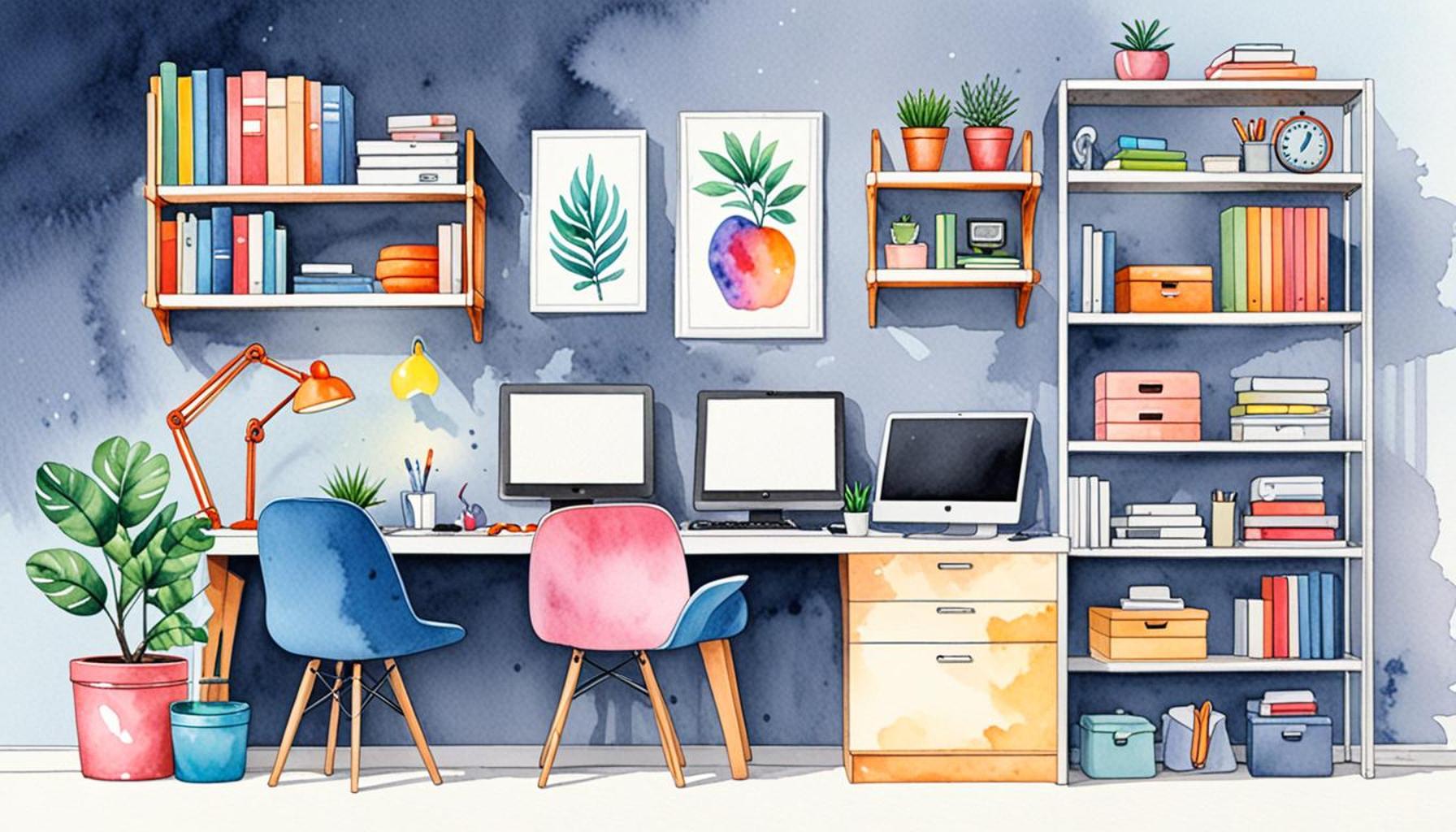Creating Comfort Zones: How Organizing Space Can Increase Productivity and Well-Being

Creating Your Comfort Zone
In an ever-demanding world, the spaces we inhabit profoundly affect our productivity and overall well-being. Finding a sense of comfort in your surroundings is not just about aesthetics; it is a crucial component of how effectively we function. Our environments can serve as a sanctuary or a stressor, depending on their organization and design.
By consciously organizing and optimizing your environment, you can enhance focus, creativity, and reduce stress levels. The impact of your surroundings on your psyche cannot be overstated. Consider how these essential elements influence your daily life:
- Clutter-Free Space: An organized workspace minimizes distractions. Research shows that clutter can inhibit cognitive function and lead to increased anxiety. For example, a study conducted by Princeton University found that clutter in the environment can divert attention and hinder task performance, making it critical to keep your workspace tidy.
- Personal Touch: Adding personal items to your space can foster a sense of belonging. This might include family photos, your favorite artwork, or even a beloved coffee mug. Such personal touches have been proven to enhance mood and create a comforting atmosphere, which can positively influence your motivation and creativity.
- Ergonomic Design: Comfortable furniture promotes better posture and reduces fatigue. Investing in an ergonomic chair or standing desk can make a significant difference in your daily comfort. According to the American Chiropractic Association, poor seating can lead to chronic pain and decreased productivity, underscoring the importance of ergonomic considerations.
For many Americans, a well-structured environment not only increases efficiency but also nurtures creativity. Research indicates that individuals who cultivate a calming workspace are more likely to experience heightened motivation and satisfaction. A calm and pleasant work environment can lead to improved focus, which is essential in today’s fast-paced world, where distractions are abundant.
In this article, we will explore practical strategies to create a comfort zone tailored to your needs. Start by decluttering your space, making it an inviting place to work or relax. Next, consider the colors and textures of your environment; studies have shown that certain colors can affect mood significantly, with blue hues promoting calm and green enhancing creativity.
By focusing on organization and design, you can unlock the potential for a more productive and fulfilling life. Embracing these changes might seem daunting initially, but the positive implications they can have on both your mental and emotional health are invaluable. Transform your surroundings thoughtfully, and you may very well be on your way to discovering a new level of comfort and productivity.

DISCOVER MORE: Click here to deepen your understanding
Elements of an Effective Comfort Zone
Understanding the essential elements that contribute to a well-organized space is crucial for anyone looking to improve their productivity and well-being. From home offices to communal workspaces, the way we arrange our environment can create a strong foundation for achieving our goals. Below are several vital components to consider when crafting your comfort zone:
- Natural Light: One of the most significant factors affecting well-being is access to natural light. Studies indicate that exposure to sunlight can boost mood and increase alertness, which leads to enhanced productivity. A Harvard study found that workers with access to natural lighting report 51% fewer eyestrain, headaches, and other ailments. Thus, positioning your workspace near windows or using light-enhancing colors can make a notable difference.
- Functional Layout: The way furniture is arranged can impact workflow and efficiency. For instance, having all necessary tools within reach minimizes disruptions and allows for a seamless work experience. Think about creating zones for different activities; perhaps a reading nook for relaxation, a creative corner for brainstorming, and a dedicated workspace for focused tasks.
- Incorporating Nature: Biophilic design, or the integration of natural elements into our environment, has been shown to improve mental health. Adding plants to your workspace not only enhances aesthetics but can also purify the air and reduce stress. The presence of greenery is linked to lower blood pressure and an overall physiological response that encourages relaxation and focus.
- Decluttering Rituals: Establishing a routine for decluttering is essential for maintaining an organized space. This could involve a short daily clean-up at the end of your workday or a more extensive weekly overhaul. Research from UCLA indicates that physical clutter can lead to mental clutter; thus, making decluttering a habit can help keep your mind clear and promote sustained productivity.
As you make these adjustments, it’s important to approach the process with a mindset of gradual change. Creating a comfort zone doesn’t happen overnight; it’s an ongoing evolution. Consider engaging in small daily practices that promote organization while allowing your space to grow and adapt to your needs.
Moreover, the psychological benefits of a well-organized environment extend beyond productivity alone. They can influence your emotional well-being and lead to better stress management. A study conducted by the National Institute of Health found that individuals exposed to organized, aesthetically pleasing environments reported an increase in feelings of happiness and satisfaction. This suggests that creating a comfort zone is not merely a practical task but an investment in your overall quality of life.
Embrace the opportunity to transform your surroundings into a sanctuary that cultivates not only efficiency but also a profound sense of well-being. With thoughtful organization and mindful design, you stand to unlock greater levels of productivity and emotional fulfillment.
Creating Functional Comfort Zones
Creating a comfort zone often begins with the organization of physical space. Studies have demonstrated that cluttered environments can lead to increased stress levels and decreased productivity. By implementing effective organization strategies, individuals can transform their spaces into serene and functional zones that foster creativity and focus.
One effective method of organization is the use of designated areas. For instance, establishing a specific work zone in your home can improve productivity by minimizing distractions. This area should be equipped with essential tools and resources, promoting a seamless workflow. In addition, enhancing the ambiance with natural light and greenery can further elevate the comfort of this space, positively impacting well-being and focus.
Furthermore, consider the psychological effects of decluttering. A tidy environment not only improves aesthetics but also enhances concentration. Techniques such as the KonMari Method, which encourages individuals to keep only items that “spark joy,” can lead to profound changes in one’s mental space. When personal belongings are organized thoughtfully, it can reinvigorate motivation and clarity, allowing individuals to thrive in their productivity.
Ultimately, the journey to creating comfort zones involves a blend of physical organization and emotional relevance. By consciously curating our spaces, we set the foundation to increase productivity and transition towards a more fulfilled life.
| Category | Advantages |
|---|---|
| Organized Workspaces | Enhances focus and reduces distractions, leading to better output. |
| Decluttering | Promotes mental clarity and reduces stress, facilitating improved mood. |
Creating comfort zones does not stop with organization but overlaps with intelligent design and personal relevance. To delve deeper into the benefits of properly curated spaces, exploring various organizational tools and methods can yield further insights into enhancing both productivity and well-being.
DISCOVER MORE: Click here to delve deeper
Strategies for Personalizing Your Comfort Zone
Creating a comfort zone tailored to your individual preferences involves personalizing your space in ways that resonate with your unique needs. While the elements discussed previously lay the groundwork for an organized environment, customization can take your productivity and well-being to new heights. Here are some strategies to effectively personalize your comfort zone:
- Color Psychology: The colors you choose for your workspace can significantly affect your mood, creativity, and overall productivity. For instance, blue tones are often associated with calmness and stability, making them an excellent choice for work that requires concentration. On the contrary, yellow tones can inspire creativity and energy, acting as a spark for brainstorming sessions. A study from the University of Texas found that people working in a blue environment demonstrated 22% higher levels of focus. Thus, consider incorporating colors that align with your personal goals and work style.
- Personal Mementos: Incorporating items that hold sentimental value can create a sense of connection and comfort within your space. Personal photos, awards, or meaningful art pieces can not only inspire creativity but also help maintain your motivation during challenging tasks. A visual reminder of your achievements and loved ones fosters an uplifting atmosphere that encourages consistent engagement and resilience.
- Ergonomics: Comfort extends beyond the appearance of your workspace to its physical functionality. Investing in ergonomic furniture that supports your posture and reduces physical strain is essential for long-term well-being. For instance, adjustable desks that allow both sitting and standing can contribute to better circulation and increased energy levels. Research from the American Journal of Preventive Medicine shows that using sit-stand desks can enhance productivity by up to 46%. Make adjustments based on your comfort while keeping usability at the forefront of your design choices.
- Aromatherapy: The power of scent should not be overlooked when crafting a productive environment. Essential oils like peppermint and rosemary are known for their stimulating effects, promoting alertness and mental clarity. A study conducted by the Journal of Neuropsychology concluded that scents can improve cognitive function significantly. Investing in an essential oil diffuser or scented candles can create an inviting ambience that subtly enhances your focus and creativity.
As you embark on the journey to personalize your comfort zone, consider the balance between aesthetics, functionality, and emotional resonance. The goal is to cultivate an environment that not only supports your daily tasks but also nurtures your mental health. Engaging regularly in this process fosters a deeper connection to your space, helming it as a whirlwind of productivity rather than a mere workspace.
Moreover, embrace the idea that your comfort zone is dynamic; it can evolve over time as your needs change. Regularly reassessing what works for you will ensure that your space remains a haven of comfort and efficiency. An environment that mirrors your personality, preferences, and passions can provide valuable motivation, enabling you to tackle tasks with renewed vigor and enthusiasm.
By taking these steps, you can convert any space into a personalized haven that supports your endeavors and bolsters your overall sense of well-being.
DIVE DEEPER: Click here to discover intentional organization strategies
Conclusion
In a world where the pace of life is ever-increasing, creating comfort zones through effective spatial organization is not just a luxury but a necessity for enhancing productivity and well-being. The strategies highlighted, from understanding color psychology to incorporating personal mementos, underscore the profound impact that a thoughtfully arranged environment can have on our mental states and work performance. As we strive for a balance between aesthetics, functionality, and personal connection, we cultivate spaces that resonate with our identities and aspirations.
Moreover, the significance of ergonomics and aromatherapy cannot be overstated. They serve as essential components in creating an atmosphere conducive to focus and creativity. Regularly evaluating and adapting our environments ensures not only adaptability but also sustained engagement with our work, reflecting the evolving nature of our personal and professional lives. Research indicates that environments tailored to our needs can dramatically uplift our mood and motivation, making the effort to design our comfort zones a worthwhile investment.
Ultimately, the journey toward crafting a personalized comfort zone is an ongoing process. As you implement the strategies discussed, remember that your space should serve as a sanctuary—one that empowers you to thrive. Embrace this transformative experience, and watch how your productivity and overall well-being flourish in response to a well-organized, personalized space. By creating comfort zones that reflect who we are and what we aspire to accomplish, we pave the way for a more fulfilling and productive future.


